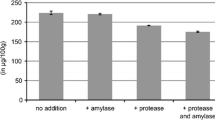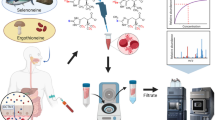Abstract
An LC–MS/MS method for analyzing seven folates in food was developed and validated. 5-Methyltetrahydrofolate, 5-formyltetrahydrofolate, 10-formylfolic acid, tetrahydrofolate and folic acid were quantified using a stable isotope dilution assay (SIDA) with deuterated analogues as internal standards. Additionally, 10-formyldihydrofolate and 5,10-methenyltetrahydrofolate were quantified using deuterated internal standards different in structure. Due to interconversion of 5,10-methenyltetrahydrofolate to 5-formyltetrahydrofolate and 10-formyldihydrofolate to 10-formylfolic acid during sample preparation, a SIDA was not considered because of a resulting double calculation of the amounts interconverting. [2H4]-5-methyltetrahydrofolate was used as internal standard for 5,10-methenyltetrahydrofolate, due to a similar retention time, and [2H4]-10-formylfolic acid as well as [2H4]-5-methyltetrahydrofolate was used for 10-formyldihydrofolate, because no internal standards co-elute. To confirm that no matrix effects affect the quantitation of 5,10-methenyltetrahydrofolate and 10-formyldihydrofolate, postcolumn infusion experiments were performed. Validation of the assay was accomplished by determining linearity, precision, recovery, limit of detection and limit of quantitation. The latter parameters were partly obtained by application of a dual-isotope label design including [13C5]-labeled folates. The amounts of 5,10-methenyltetrahydrofolate in the purified extracts of different food samples ranged between 0.3 and 1.3 % and for 10-HCO-H2folate between 0.05 and 8 % of the total folate amount. Correction for incomplete recovery of the latter folate during cleanup indicates even higher contents. Therefore, especially 10-formyldihydrofolate should not be neglected to obtain accurate results for folates.





Similar content being viewed by others
References
Arnesen E, Refsum H, Bonaa KH, Ueland PM, Forde OH, Nordrehaug JE (1995) Serum total homocysteine and coronary heart-disease. Int J Epidemiol 24(4):704–709
Czeizel AE, Dudas I (1992) Prevention of the first occurrence of neural-tube defects by periconceptional vitamin supplementation. N Engl J Med 327(26):1832–1835
Robinson K (2000) Homocysteine, B vitamins, and risk of cardiovascular disease. Heart 83(2):127–130
Beck WS (1991) Diagnosis of megaloblastic-anemia. Annu Rev Med 42:311–322
Food and Nutrition Board—Institute of Medicine (1998) Dietary reference intakes for thiamin, riboflavin, niacin, vitamin B6, folate, vitamin B12, pantothenic acid, biotin, and choline. National Academy Press, Washington, DC
Gregory JF, Bhandari SD, Bailey LB, Toth JP, Baumgartner TG, Cerda JJ (1992) Relative bioavailability of deuterium-labeled monoglutamyl tetrahydrofolates and folic acid in human subjects. Am J Clin Nutr 55(6):1147–1153
Rychlik M (2009) Die Vitamine der Folatgruppe, Eine Übersicht. Deut Lebensm-Rundschau 105(5):292–296
Annesley TM (2003) Ion suppression in mass spectrometry. Clin Chem 49(7):1041–1044
Freisleben A, Schieberle P, Rychlik M (2003) Specific and sensitive quantification of folate vitamers in foods by stable isotope dilution assays using high-performance liquid chromatography-tandem mass spectrometry. Anal Bioanal Chem 376(2):149–156
Gutzeit D, Moench S, Jerz G, Winterhalter P, Rychlik M (2008) Folate content in sea buckthorn berries and related products (Hippophae rhamnoides L. ssp rhamnoides): LC-MS/MS determination of folate vitamer stability influenced by processing and storage assessed by stable isotope dilution assay. Anal Bioanal Chem 391(1):211–219
Buettner BE, Ohrvik VE, Witthoft CM, Rychlik M (2011) Quantification of isotope-labelled and unlabelled folates in plasma, ileostomy and food samples. Anal Bioanal Chem 399(1):429–439
Vishnumohan S, Arcot J, Pickford R (2010) Naturally-occurring folates in foods: Method development and analysis using liquid chromatography–tandem mass spectrometry (LC–MS/MS). Food Chem 125(2):736–742
Zhang GF, Storozhenko S, van der Straeten D, Lambert WE (2005) Investigation of the extraction behavior of the main monoglutamate folates from spinach by liquid chromatography-electrospray ionization tandem mass spectrometry. J Chromatogr A 1078(1–2):59–66
Garratt LC, Ortori CA, Tucker GA, Sablitzky F, Bennett MJ, Barrett DA (2005) Comprehensive metabolic profiling of mono- and polyglutamated folates and their precursors in plant and animal tissue using liquid chromatography/negative ion electrospray ionisation tandem mass spectrometry. Rapid Commun Mass Spectrom 19(17):2390–2398
Phillips KM, Ruggio DM, Ashraf-Khorassani M, Haytowitz DB (2006) Difference in folate content of green and red sweet peppers (Capsicum annuum) determined by liquid chromatography-mass spectrometry. J Agric Food Chem 54(26):9998–10002
de Brouwer V, Storozhenko S, van de Steene JC, Wille SMR, Stove CP, van der Straeten D, Lambert WE (2008) Optimisation and validation of a liquid chromatography-tandem mass spectrometry method for folates in rice. J Chromatogr A 1215(1–2):125–132
Wang C, Riedl KM, Somerville J, Balasubramaniam VM, Schwartz SJ (2011) Influence of high-pressure processing on the profile of polyglutamyl 5-methyltetrahydrofolate in selected vegetables. J Agric Food Chem 59(16):8709–8717
Munyaka AW, Oey I, Verlinde P, van Loey A, Hendrickx M (2009) Acidification, crushing and thermal treatments can influence the profile and stability of folate poly-gamma-glutamates in broccoli (Brassica oleracea L. var. italica). Food Chem 117(3):568–575
de Brouwer V, Zhang G, Storozhenko S, van der Straeten D, Lambert WE (2007) pH stability of individual folates during critical sample preparation steps in prevision of the analysis of plant folates. Phytochem Anal 18(6):496–508
Wilson SD, Horne DW (1984) High-performance liquid-chromatographic determination of the distribution of naturally-occurring folic acid derivatives in rat liver. Anal Biochem 142(2):529–535
O’Broin JD, Temperley IJ, Brown JP, Scott JM (1975) Nutritional stability of various naturally occurring monoglutamate derivatives of folic acid. Am J Clin Nutr 28(5):438–444
Pfeiffer CM, Rogers LM, Gregory JF (1997) Determination of folate in cereal-grain food products using trienzyme extraction and combined affinity and reversed-phase liquid chromatography. J Agric Food Chem 45(2):407–413
Ruggeri S, Vahteristo LT, Aguzzi A, Finglas P, Carnovale E (1999) Determination of folate vitamers in food and in Italian reference diet by high-performance liquid chromatography. J Chromatogr A 855(1):237–245
Konings EJ, Roomans HH, Dorant E, Goldbohm RA, Saris WH, van den Brandt PA (2001) Folate intake of the Dutch population according to newly established liquid chromatography data for foods. Am J Clin Nutr 73(4):765–776
Kariluoto MS, Vahteristo LT, Piironen VI (2001) Applicability of microbiological assay and affinity chromatography purification followed by high-performance liquid chromatography (HPLC) in studying folate contents in rye. J Sci Food Agric 81(9):938–942
Baggott JE, Tamura T (2001) Metabolism of 10-formyldihydrofolate in humans. Biomed Pharmacother 55(8):454–457
Freisleben A, Schieberle P, Rychlik M (2002) Syntheses of labeled vitamers of folic acid to be used as internal standards in stable isotope dilution assays. J Agric Food Chem 50(17):4760–4768
Tyagi A, Penzkofer A, Batschauer A, Wolf E (2009) Thermal degradation of (6R, S)-5,10-methenyltetrahydrofolate in aqueous solution at pH 8. Chem Phys 358(1–2):132–136
Vogelgesang J, Haedrich J (1998) Limits of detection, identification and determination: a statistical approach for practitioners. Accred Qual Assur 3(6):242–255
Baggott JE, Johanning GL, Branham KE, Prince CW, Morgan SL, Eto I, Vaughn WH (1995) Cofactor role for 10-formyldihydrofolic acid. Biochem J 308(Part 3):1031–1036
Baggott JE, Johanning GL (1999) 10-Formyl-dihydrofolic acid is bioactive in human leukemia cells. J Nutr 129(7):1315–1318
Baram J, Chabner BA, Drake JC, Fitzhugh AL, Sholar PW, Allegra CJ (1988) Identification and biochemical-properties of 10-formyldihydrofolate, a novel folate found in methotrexate-treated cells. J Biol Chem 263(15):7105–7111
Holcapek M, Jandera P (1999) Interpretation of electrospray and atmospheric pressure chemical ionization mass spectra of 10-formyl-7,8-dihydrofolic acid and 5-formyl-5,6,7,8-tetrahydropteroic acid. Rapid Commun Mass Spectrom 13(14):1423–1426
Pedersen JC (1988) Comparison of γ-glutamyl hydrolase (conjugase; EC 3.4.22.12) and amylase treatment procedures in the microbiological assay for food folates. Br J Nutr 59(2):261–271
Matuszewski BK, Constanzer ML, Chavez-Eng CM (2003) Strategies for the assessment of matrix effect in quantitative bioanalytical methods based on HPLC-MS/MS. Anal Chem 75(13):3019–3030
Rychlik M, Netzel M, Pfannebecker I, Frank T, Bitsch I (2003) Application of stable isotope dilution assays based on liquid chromatography-tandem mass spectrometry for the assessment of folate bioavailability. J Chromatogr B 792(2):167–176
Acknowledgments
This study was supported by a grant from the Deutsche Forschungsgemeinschaft (RY, 19/7-2). Moreover, the authors gratefully acknowledge the support by the Faculty Graduate Center Weihenstephan of TUM Graduate School at Technische Universität München, Germany.
Author information
Authors and Affiliations
Corresponding author
Electronic supplementary material
Below is the link to the electronic supplementary material.
Rights and permissions
About this article
Cite this article
Ringling, C., Rychlik, M. Analysis of seven folates in food by LC–MS/MS to improve accuracy of total folate data. Eur Food Res Technol 236, 17–28 (2013). https://doi.org/10.1007/s00217-012-1849-x
Received:
Revised:
Accepted:
Published:
Issue Date:
DOI: https://doi.org/10.1007/s00217-012-1849-x




